Project management is a vast field. It spans multiple industries and requires a variety of skills. One commonality within the field of project management is the techniques project managers use to complete the job.
No matter the industry or project, project management techniques can help teams plan, manage, and ensure a project’s success. Though there are many project management techniques out there, we rounded up our top eight favorites that every project manager should know.
Let’s get started!
Don’t miss more quality content!
1. Work breakdown structure (WBS)
What it is: instead of dealing with a behemoth of a project that feels overwhelming, smart project managers break the work into more manageable tasks, a strategy called work breakdown structure.
How it works: this isn’t just about taking something complicated and breaking it down into smaller parts. Using the WBS technique, it’s easier to organize smaller tasks into a workflow than larger ones.
Why it works: when breaking down a project into smaller bites, teams can see which tasks depend on others and when to complete them. It’s also significantly easier to estimate how much time and money to spend on each task.
This makes resource planning and managing stakeholder’s expectations smoother.
To get started, check out monday.com’s robust Work Breakdown Structure template.
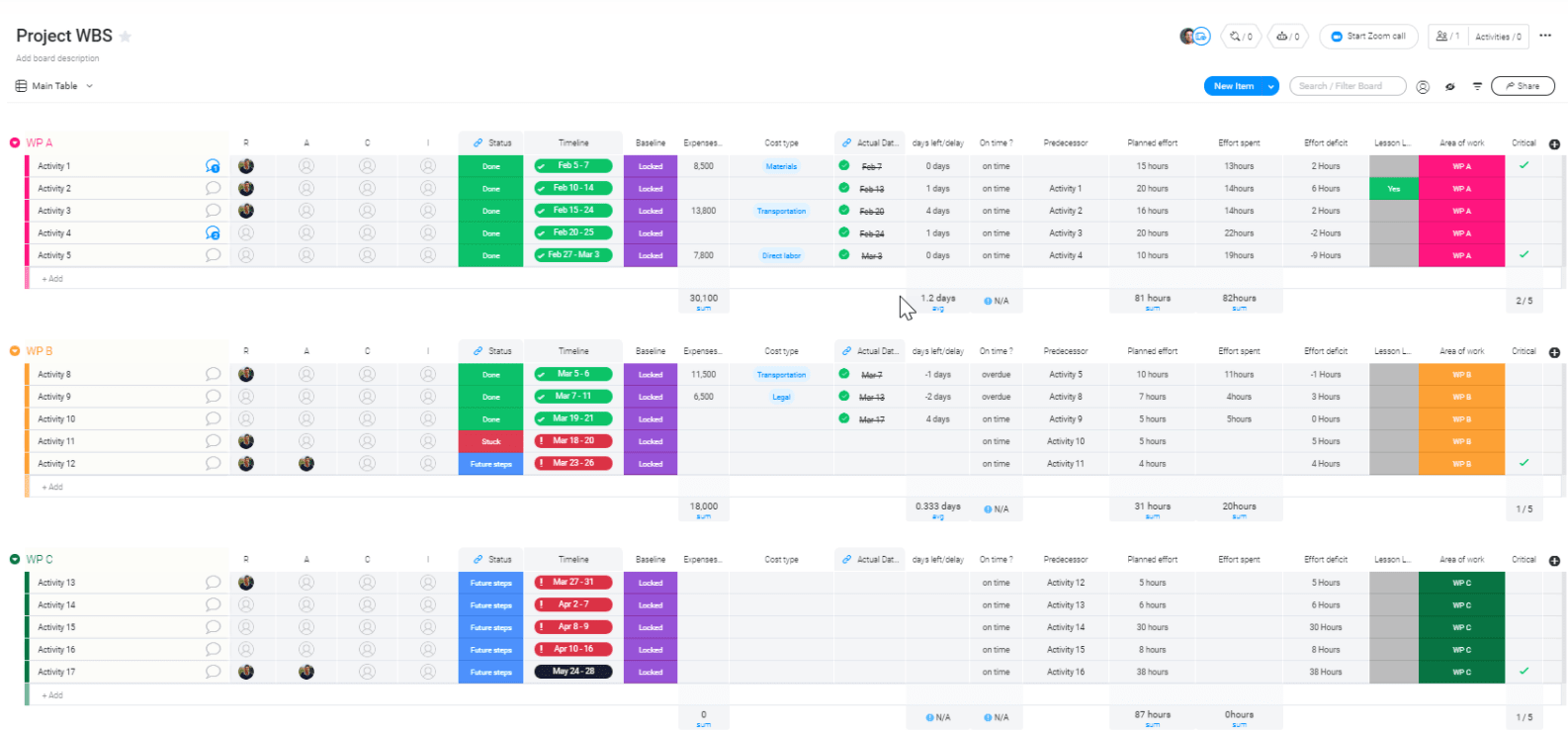
You can list all your tasks and estimate duration, budget, and effort, plus, easily assign resources and identify dependencies on monday.com.
With the Work OS’s drag-and-drop functionality, it’s easy to play around until you’ve got it perfect.
2. Critical Path Method (CPM)
What it is: a technique used in estimating and monitoring a project’s overall duration. When a project is broken down into tasks, each has an estimated duration.
How it works: those tasks are organized by delivery based on logic and any dependencies. When adding up the duration of the longest sequence of tasks, you’ll get an estimate of the overall project duration.
If any tasks are delayed, the project duration increases.
Why it works: monitoring and controlling tasks on the critical path help teams deliver projects on time.
For more information, check out our no-nonsense guide to critical paths.
3. Scrum
What it is: Scrum is the most common framework within the Agile methodology. It defines the project goal over a series of short development cycles known as “sprints.”
How it works: teams refine the high-level scope through iterations. At the start of the sprint, teams figure out how many items they can commit to and create a sprint backlog (a list of the tasks to perform during the sprint).
Why it works: these iterations improve the likelihood of delivering a product that fully satisfies customer requirements. Plus they can deliver a viable product earlier than in more traditional methodologies, which is important for businesses where speed-to-market is crucial.
monday.com’s Work OS offers a range of in-platform collaboration tools that support this. Users can share, view, and update in real-time project documentation, so everyone stays on the same page.
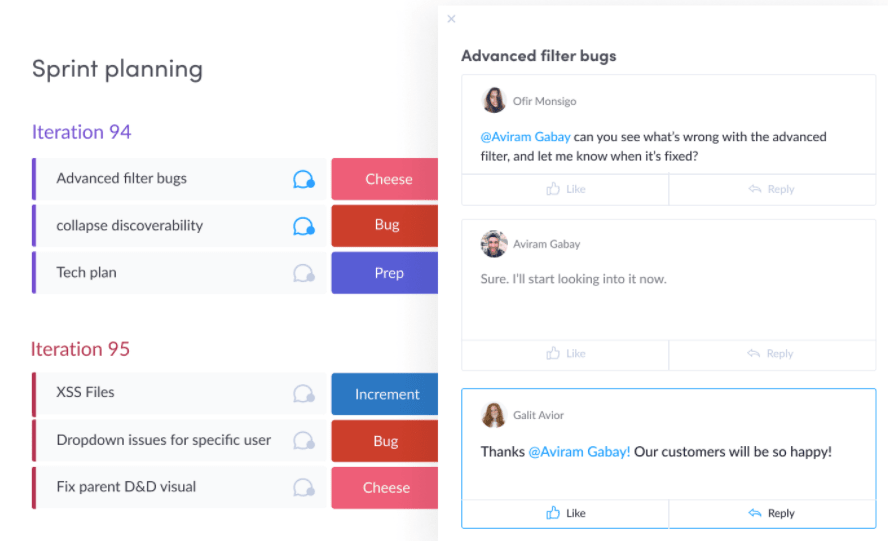
With monday.com’s integrations — such as with Jira or Gitlab for bug tracking and issue management — if you change something on one platform, it’ll change on the others. This way, you’ll always have the most up-to-date information.
4. SAFe
What it is: the Scaled Agile Framework (SAFe) implements Agile project management at scale.
There are 4 levels for organizations of different sizes and requirements — Essential, Large Solution, Portfolio, and Full.
How it works: As an organization grows, SAFe’s agile practices provide a framework that enables teams to develop better products by responding quickly to changing market conditions, customer’s needs, and newly developed technologies.
Why it works: a 2020 study found that SAFe improved collaboration with teams and increased efficiency. Overall, leveraging the power of SAFe allows companies to make faster decisions, communicate more effectively, optimize operations, and stay focused on the customer.
Read here for an in-depth comparison of SaFe vs Scrum Agile.
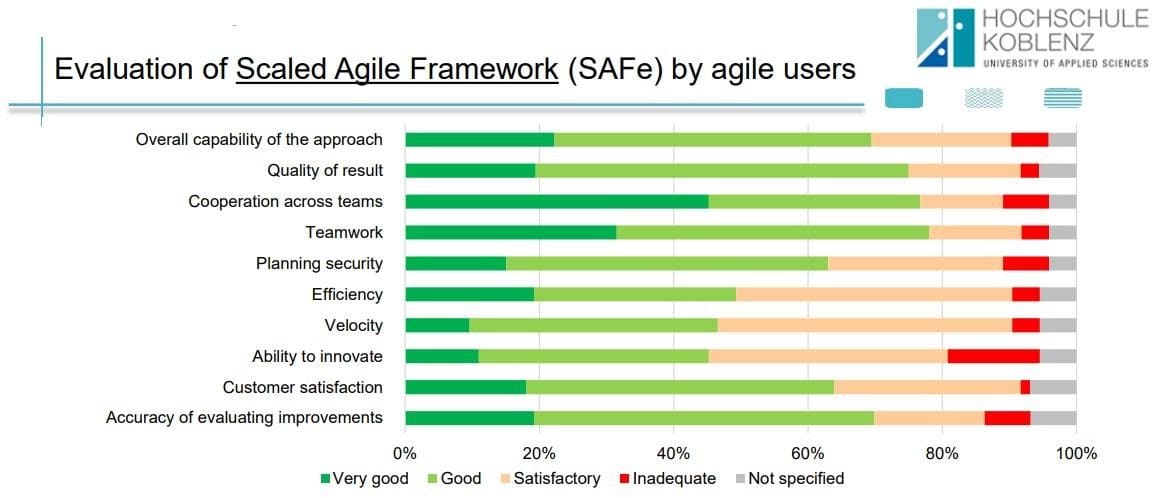
5. Kanban
What it is: in Kanban, a project’s workflow is broken down into smaller tasks. These tasks are then organized and displayed, so everyone on the team is aware of project progress.
How it works: often, tasks on a Kanban software are separated into columns. A classic Kanban board shows 3 columns assigning tasks a status of:
- To-do
- Doing
- Done
One popular addition is a ‘Stuck’ column, to show tasks that are in-progress but not progressing for some reason.
Why it works: Kanban is great for projects with sequential workflows and limited dependencies that allow team members to concentrate on their own tasks.
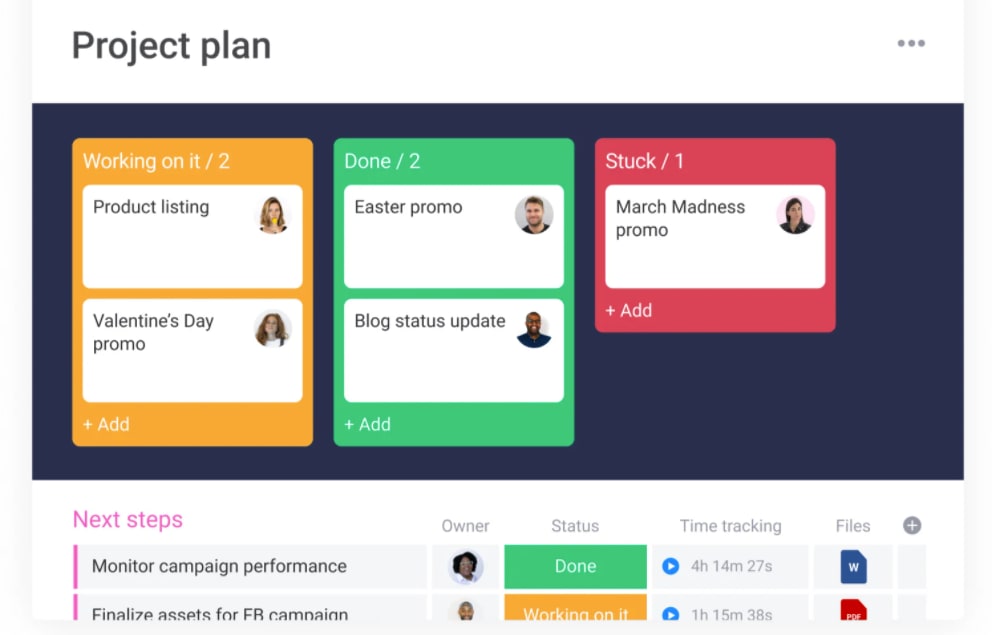
monday.com’s colorful, intuitive interface makes setting up a Kanban board simple.
Plus, the additional transparency improves focus and motivation as each person can focus on their own work. On Kanban, team members can see how everyone contributes to the overall goal.
6. Gantt
What is it: a Gantt chart is a bar chart allows you to visualize project activities over time. It’s especially useful because it shows what work needs to be completed on specific days.
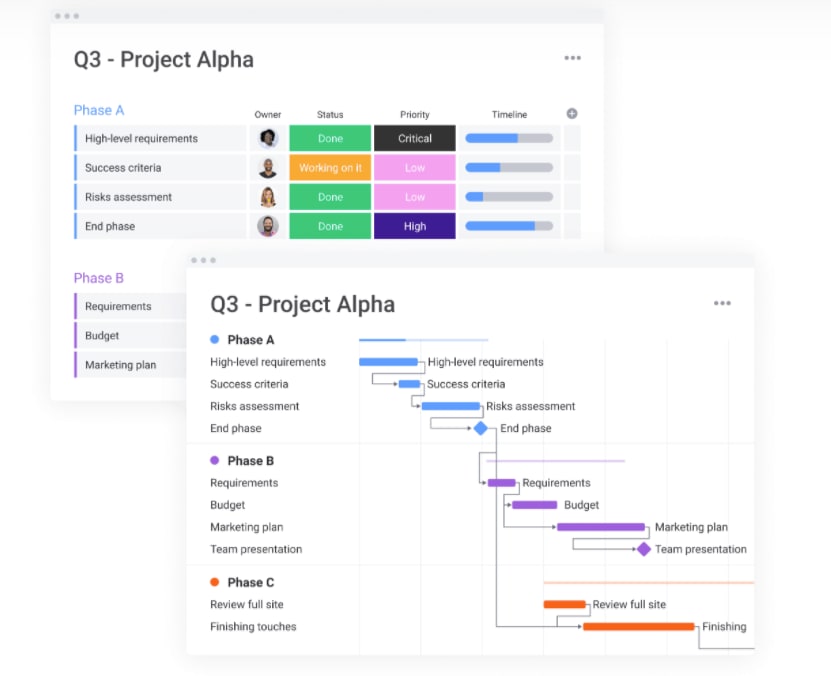
How it works: Gantt charts allow project managers to determine — at a glance — current project progress and take any action to bring the project back on schedule.
Why it works: Gantt charts show:
- The start date of the project
- The project tasks
- Which team member is working on what task
- When tasks start and finish
- How long tasks take
- Task dependencies and milestones
Don’t miss more quality content!
7. PERT
What is is: PERT isn’t just focused on the critical path’s duration, but also the relationships between project tasks.
PERT shows project tasks arranged more like a flowchart than sequential events.
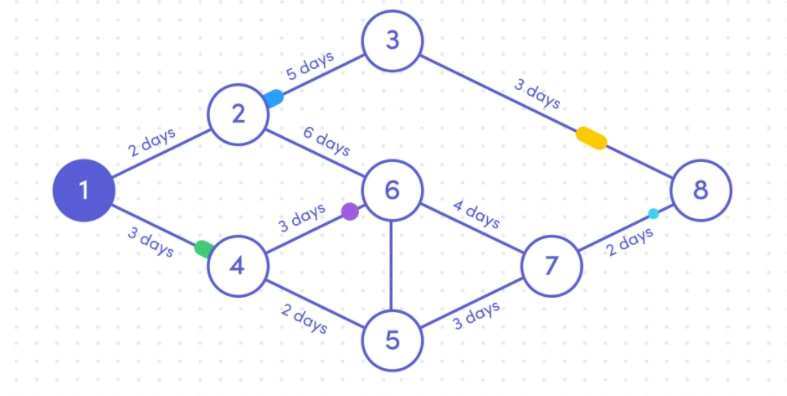
How it works: this method improves the accuracy of task duration estimates by using 3 possible inputs for the calculation:
- Optimistic time
- Pessimistic time
- Most-likely time
Why it works: This can get pretty detailed so for more information, check out our guide to PERT.
8. Waterfall
What it is: Waterfall is a structured and linear approach to organizing and controlling projects.
How it works: teams divide a project into distinct phases, with each new phase beginning only when competing the previous one.
Why it works: the distinct phases make project planning simple. It’s also easy to monitor if the project is on track.
That makes it good for projects that need to commit to a fixed timeline or budget, such as large infrastructure projects.
Not sure whether a Waterfall or Agile methodology might suit you and your team? read our review of agile vs waterfall methodologies.
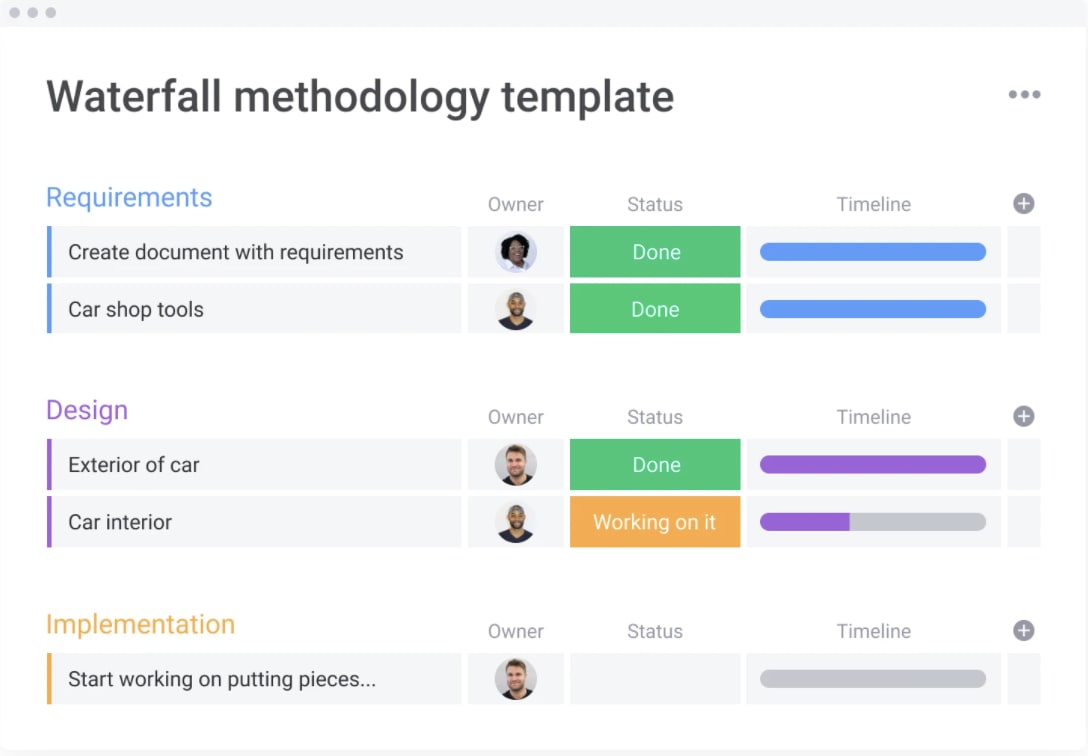
9. Agile project management
What it is: Agile project management is a flexible, iterative approach ideal for software development and projects where customer needs frequently change. It emphasizes collaboration, quick delivery, and adaptability to ensure customer satisfaction.
How it works: Projects are divided into smaller tasks called iterations or sprints, usually lasting one to four weeks. Cross-functional teams work collaboratively during each sprint to plan, develop, test, and review deliverables, allowing for quick adjustments based on continuous feedback.
Why it works: the Agile method enables teams to quickly respond to changes, reducing risks in complex projects. Frequent deliveries and stakeholder involvement ensure the project stays aligned with goals, fostering collaboration, transparency, and better resource allocation.
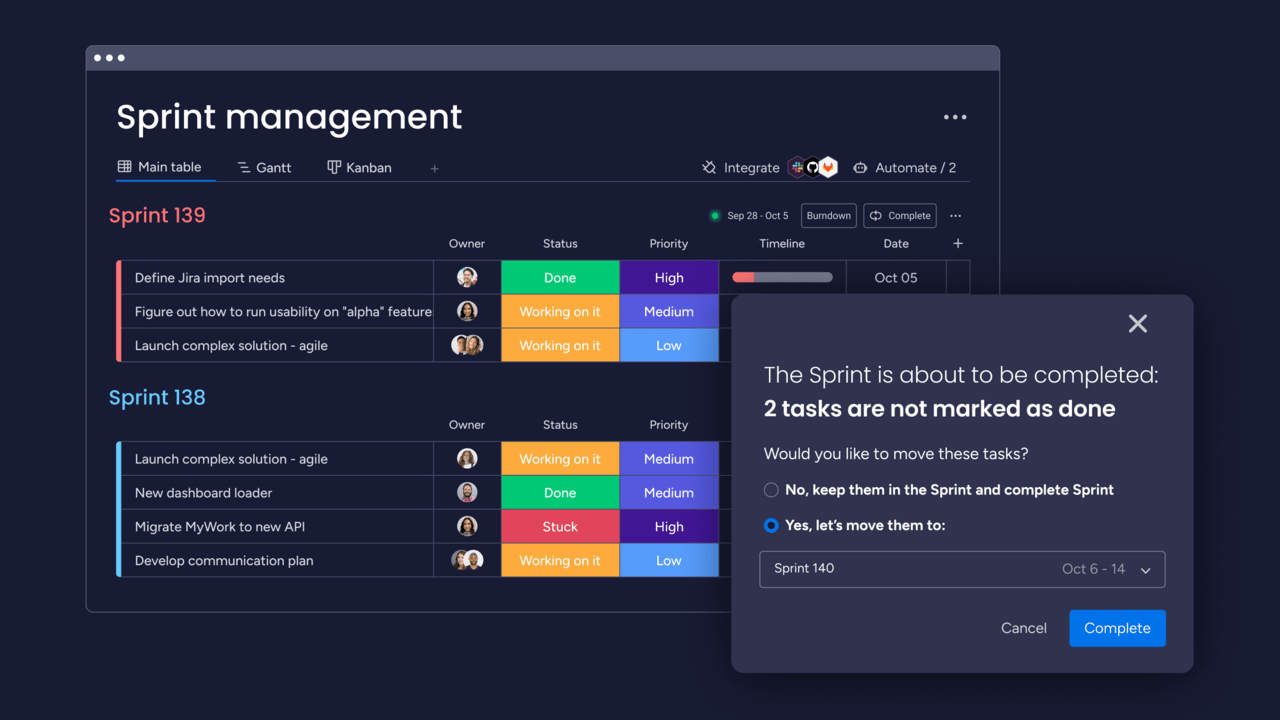
10. The RACI model
What it is: RACI is a project management tool used to clarify roles and responsibilities within a project. It stands for Responsible, Accountable, Consulted, and Informed, ensuring everyone knows their specific duties.
How it works: Each task in the project is assigned to one of the RACI categories. The Responsible person does the work, the Accountable person ensures it’s completed, the Consulted people provide input, and the Informed individuals are kept updated on progress.
Why it works: RACI enhances clear communication and reduces confusion by defining roles and responsibilities for each task. This ensures that the project team is aligned, objectives are met, and everyone meets the project deadlines more efficiently.
11. Earned Value Management (EVM)
What it is: Earned Value Management (EVM) is a project management methodology that measures project performance and progress objectively. It integrates project scope, time, and cost to provide accurate forecasts of the progress and when things will be completed.
How it works: EVM uses various metrics to compare planned work with actual progress and costs. By analyzing these metrics, project managers can identify deviations from the project plan and adjust their strategies accordingly to keep the project on track.
Why it works: EVM provides a clear visual representation of project status, helping teams manage complex projects efficiently. It ensures timely adjustments, enabling successful projects that meet project deadlines and stay within the project budget.
12. Stakeholder Mapping
What it is: Stakeholder mapping is used to identify and analyze project stakeholders. The worst thing you can do is to start a project without having everyone on board. This tool helps in understanding the needs of each stakeholder, and their expectations and influence on the project.
How it works: Project managers create a visual map to categorize stakeholders based on their level of interest and influence. This aids in developing communication strategies and engagement plans to ensure stakeholder satisfaction and project success.
Why it works: Stakeholder mapping ensures that all project stakeholders are considered during the project management process. It enhances communication capabilities and aligns project objectives with stakeholder needs, leading to better project outcomes.
13. Critical Chain Project Management (CCPM)
What it is: Critical Chain Project Management (CCPM) is a method of project management that focuses on resource management and addresses resource constraints. It modifies the critical path method to account for resource dependencies.
How it works: CCPM builds task buffers or extra time into the project timeline to protect critical tasks from delays. By prioritizing resources and managing buffer times, it ensures that the project timeline is met even when unexpected issues arise.
Why it works: CCPM helps in managing complex projects by optimizing resource allocation and reducing project duration. It improves project performance and ensures project completion within the planned time frame.
14. Rational Unified Process (RUP)
What it is: Rational Unified Process (RUP) is an iterative software development framework that provides a disciplined approach to assigning tasks and responsibilities within a development team. It is designed to ensure the production of high-quality software that meets end-user needs.
How it works: RUP divides the project lifecycle into four phases: Inception, Elaboration, Construction, and Transition. Each phase has specific objectives, deliverables, and milestones, ensuring that the project adheres to defined project requirements and project scope.
Why it works: RUP’s iterative nature allows for frequent reviews and adjustments, ensuring that project objectives are met. It is especially beneficial for managing dynamic, ever-changing software development projects by maintaining control over the entire project lifecycle.
15. PRINCE2
What it is: PRINCE2 (Projects IN Controlled Environments) is a structured project management methodology that emphasizes clear organization and control throughout the project life cycle. It is scalable and can be tailored to suit any type of project.
How it works: PRINCE2 divides the project into manageable stages, each with its own set of project plans and project management processes. It provides clear guidance on roles, responsibilities, and procedures to ensure that all aspects of the project are managed effectively.
Why it works: PRINCE2 enhances project control by breaking down complex projects into phases, making it easier to manage and track progress. It ensures that all project deliverables are aligned with business objectives and stakeholders’ expectations.
16. Extreme Project Management (XPM)
Traditional project management methodologies typically follow a linear, structured approach with a clear project timeline, well-defined project scope, and precise time estimates. Sometimes these methods don’t work for certain projects – meet XPM.
What it is: Extreme Project Management (XPM) is a flexible and adaptive project management methodology designed for highly dynamic and ambiguous projects where requirements and outcomes are uncertain. It is particularly useful in environments with rapid changes and frequent iterations.
How it works: XPM focuses on iterative planning and frequent reassessment of project goals and deliverables. It involves constant collaboration within the project team and with project stakeholders, allowing for quick adjustments and continuous alignment with evolving project requirements.
Why it works: XPM thrives in unpredictable scenarios by encouraging iterative progress and regular feedback. This method helps in managing complex projects efficiently, reducing the risk of project chaos, and ensuring successful project completion despite frequent changes.
17. Extreme programming
What it is: Extreme programming (XP) is an Agile framework used in software development.
How it works: XP ensures the development of high-quality software while enabling a positive environment for the development team.
XP is supported by 5 core values, including simplicity. This is about producing the simplest product viable, reducing waste and making maintenance and support easier.
The most appropriate use of XP is within a project that has a small, co-located development team and system software requirements that change frequently.
Why it works: XP focuses on customer satisfaction. Instead of delivering everything far in the future, teams create software as needed.
18. Use project management software
Project management software helps you organize and manage your projects more easily, and all in one place. monday work management helps you break larger projects into manageable chunks by keeping tabs on individual tasks, tagging the appropriate people, integrate and automating workflows
Some of the things you can do on monday work management are:
- Create customizable boards and project dashboards
- Automate repetitive tasks by integrating with tools like Slack, Gmail, and Teams
- Create Gantt chart and timeline views for each board
- Mention and tag team members and leave comments for seamless communication
- Attach files directly to your boards
- Use advanced integrations with API access and Zapier
19. Use the best project management templates
The larger the project the harder it is to visualize everything that’s happening and know the progress and status of each task. That’s why you need a visual representation of your project, and depending on your needs you may want to start with a template to speed things up.
The best part – you can create many different views from one template, whether that’s a timeline view, a gantt chart, or a kanban. Here are some of our most popular templates for managing projects.
Action plan template
To execute a project well you need a strategy. Use our action plan template to assign specific tasks, set timelines, set clear objectives and create a streamlines and efficient workflow for the entire project team.
Gantt chart template
Gantt charts are great for visualizing the timeline and status of each task, identifying potential bottlenecks, and seeing what’s stuck and why. It’s like a project schedule view on steroids. Check out our Gantt chart template.
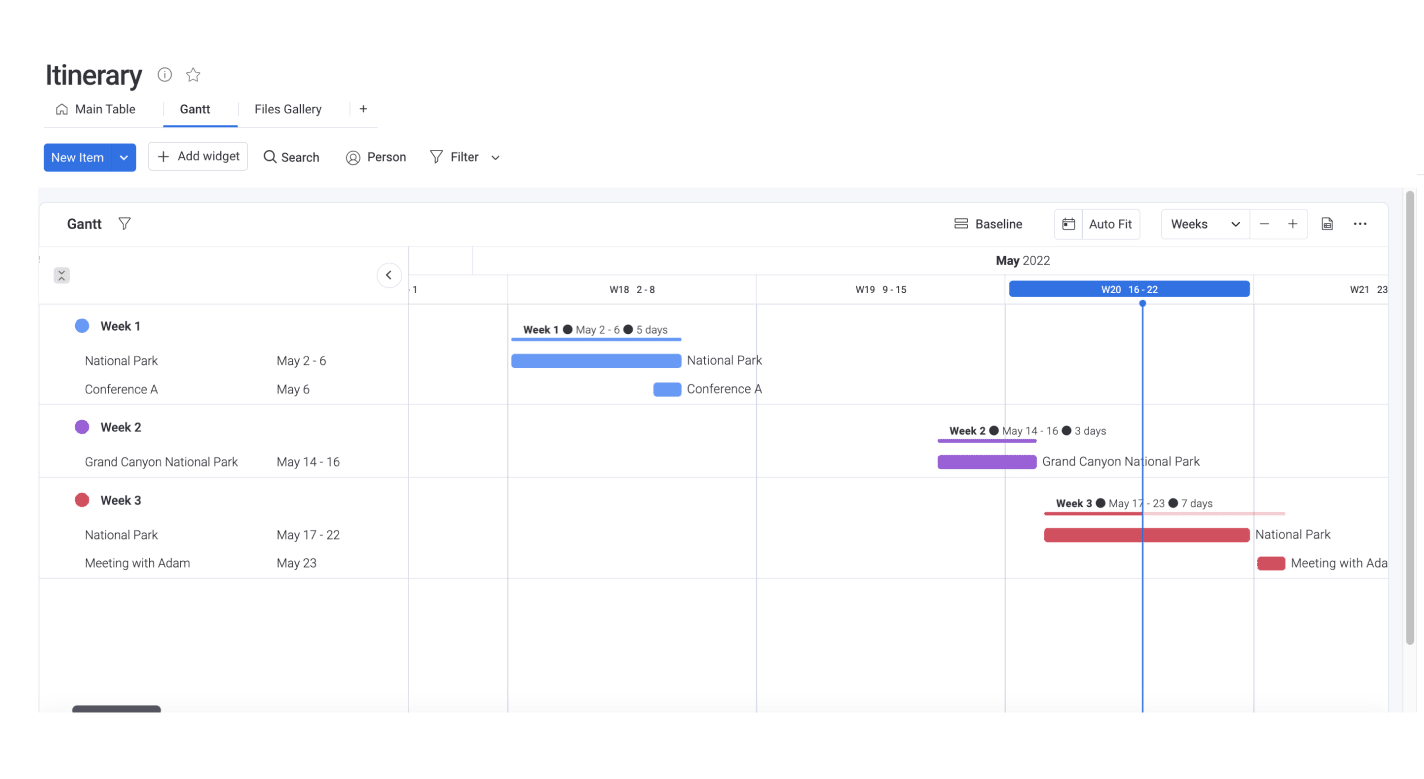
RACI matrix template
Our RACI template is a great way to clearly define and communicate team roles and responsibilities, ensuring accountability and avoiding overlaps in project tasks.
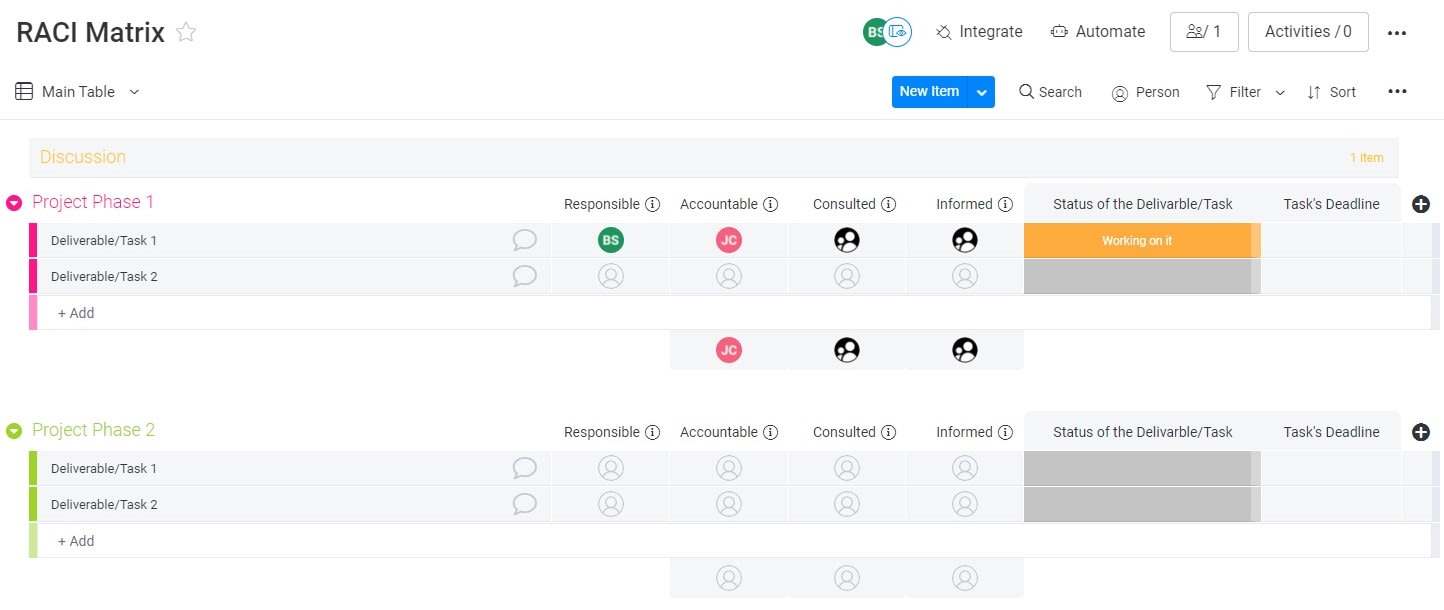
Work breakdown structure template
This template enables managers to decompose projects into manageable tasks, facilitating better planning, resource allocation, and overall project oversight.
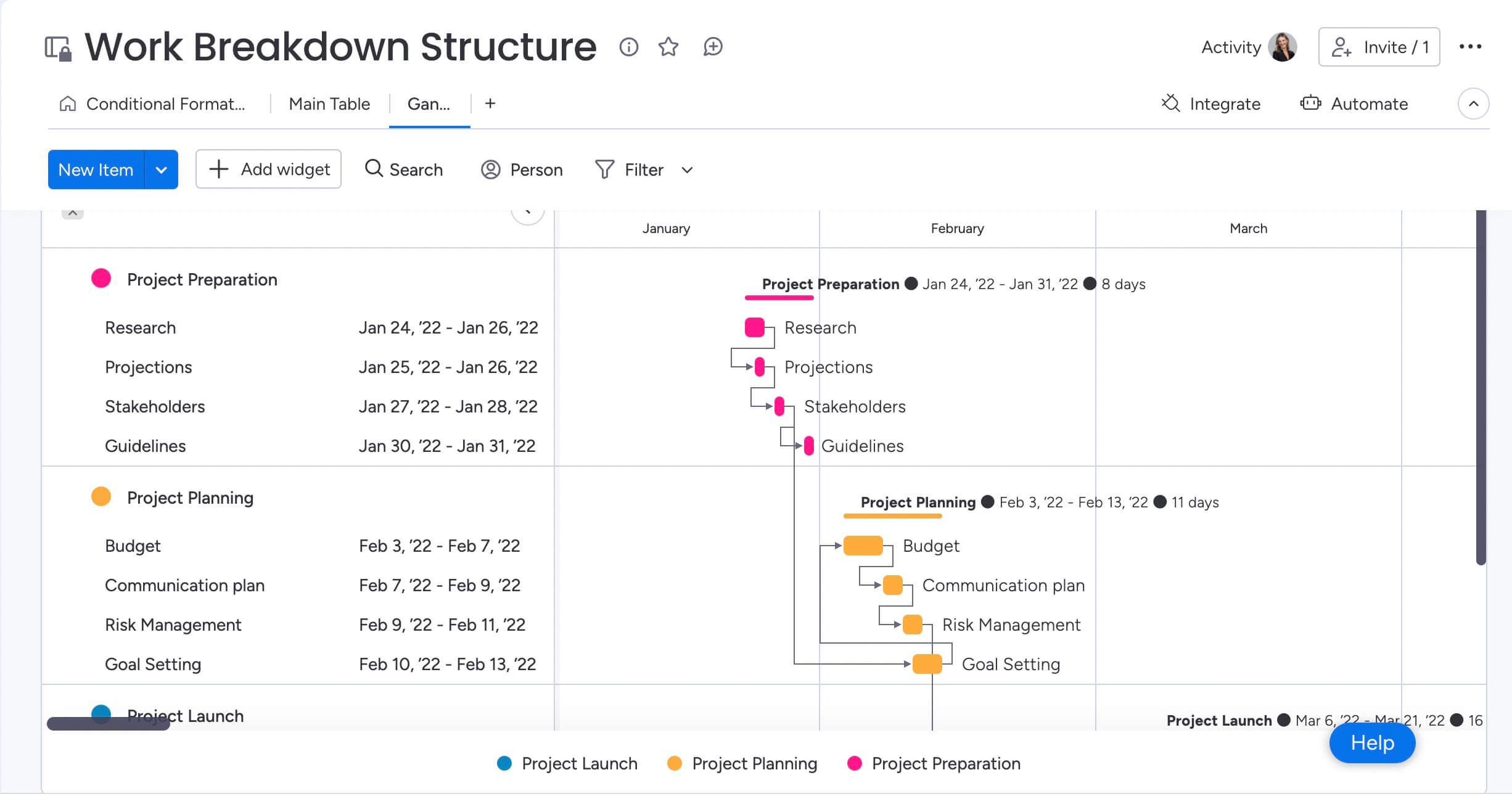
Marketing budget template
Managers can use our marketing budget template to plan, allocate, and monitor financial resources (whether marketing-related or not), ensuring all activities are funded appropriately and costs remain within budget constraints.
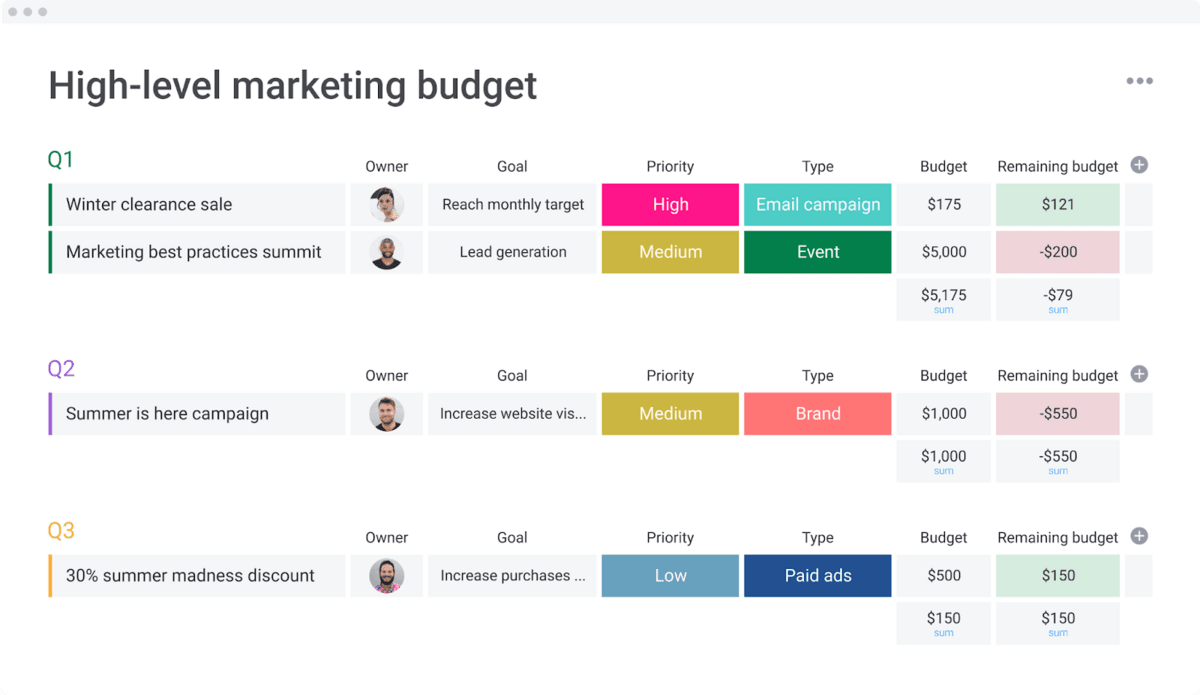
Improve your projects this year with these techniques
We’ve explored our top eight project management techniques that will ensure your project’s success from A-Z. Whichever one you decide to go for, monday.com has you covered.
Our Work OS has all the building blocks to manage your project the way you want it. Let monday.com flex and grow right alongside you. Get started now and find your new favorite project management techniques with our project proposal template.
Don’t miss more quality content!
Don’t miss more quality content!
